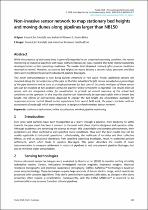 ResearchSpace
ResearchSpace
Non-invasive sensor network to map stationary bed heights and moving dunes along pipelines larger than NB150
JavaScript is disabled for your browser. Some features of this site may not work without it.
- ResearchSpace
- →
- Research Publications/Outputs
- →
- Conference Publications
- →
- View Item
| dc.contributor.author |
Ilgner, Hartmut J

|
|
| dc.contributor.author |
Kruger, Carel P

|
|
| dc.date.accessioned | 2018-07-17T12:03:11Z | |
| dc.date.available | 2018-07-17T12:03:11Z | |
| dc.date.issued | 2018-04 | |
| dc.identifier.citation | Ilgner, H.J. and Kruger, C.P. 2018. Non-invasive sensor network to map stationary bed heights and moving dunes along pipelines larger than NB150. 21st International Seminar on Paste and Thickened Tailings, 11-13 April 2018, Perth, Australia | en_US |
| dc.identifier.isbn | 978-0-9924810-8-7 | |
| dc.identifier.uri | https://papers.acg.uwa.edu.au/p/1805_11_Ilgner/ | |
| dc.identifier.uri | http://hdl.handle.net/10204/10307 | |
| dc.description | Open access paper presented at the 21st International Seminar on Paste and Thickened Tailings, 11-13 April 2018, Perth, Australia | en_US |
| dc.description.abstract | While the presence of stationary beds is generally regarded as an undesired operating condition, the recent monitoring of industrial pipelines with novel instrumentation has now revealed that beds indeed repeatedly developed under certain operating conditions. The smaller beds depleted routinely after process conditions returned to normal. However, as soon as bed heights increased beyond a certain value, pressures and flow rates were insufficient to prevent subsequent pipeline blockages. This novel instrumentation is now being further enhanced in two ways. Firstly, additional sensors are mounted along the circumference of the pipe so that the actual bed height can be provided as a percentage of the pipe diameter and be used as a single parameter for bed control. Secondly, multiples of these sensor sets can be installed at key locations along the pipeline where settlement is expected. The results from all sensor sets are integrated online for visualisation to provide an instant overview of the actual bed conditions to the operator. In this way the pipeline can intentionally be operated safely with a known bed height. The effects of interventions deployed to change the bed height are immediately available for responsive process control. Based on the experiences from recent field work, the paper concludes with an assessment of trade-offs which were necessary to design a reliable wireless sensor network. | en_US |
| dc.language.iso | en | en_US |
| dc.publisher | Australian Centre for Geomechanics | en_US |
| dc.relation.ispartofseries | Worklist;21022 | |
| dc.subject | Industrial pipelines | en_US |
| dc.subject | Stationary beds | en_US |
| dc.subject | Online visualisation | en_US |
| dc.subject | Wireless pipeline monitoring | en_US |
| dc.title | Non-invasive sensor network to map stationary bed heights and moving dunes along pipelines larger than NB150 | en_US |
| dc.type | Conference Presentation | en_US |
| dc.identifier.apacitation | Ilgner, H. J., & Kruger, C. P. (2018). Non-invasive sensor network to map stationary bed heights and moving dunes along pipelines larger than NB150. Australian Centre for Geomechanics. http://hdl.handle.net/10204/10307 | en_ZA |
| dc.identifier.chicagocitation | Ilgner, Hartmut J, and Carel P Kruger. "Non-invasive sensor network to map stationary bed heights and moving dunes along pipelines larger than NB150." (2018): http://hdl.handle.net/10204/10307 | en_ZA |
| dc.identifier.vancouvercitation | Ilgner HJ, Kruger CP, Non-invasive sensor network to map stationary bed heights and moving dunes along pipelines larger than NB150; Australian Centre for Geomechanics; 2018. http://hdl.handle.net/10204/10307 . | en_ZA |
| dc.identifier.ris | TY - Conference Presentation AU - Ilgner, Hartmut J AU - Kruger, Carel P AB - While the presence of stationary beds is generally regarded as an undesired operating condition, the recent monitoring of industrial pipelines with novel instrumentation has now revealed that beds indeed repeatedly developed under certain operating conditions. The smaller beds depleted routinely after process conditions returned to normal. However, as soon as bed heights increased beyond a certain value, pressures and flow rates were insufficient to prevent subsequent pipeline blockages. This novel instrumentation is now being further enhanced in two ways. Firstly, additional sensors are mounted along the circumference of the pipe so that the actual bed height can be provided as a percentage of the pipe diameter and be used as a single parameter for bed control. Secondly, multiples of these sensor sets can be installed at key locations along the pipeline where settlement is expected. The results from all sensor sets are integrated online for visualisation to provide an instant overview of the actual bed conditions to the operator. In this way the pipeline can intentionally be operated safely with a known bed height. The effects of interventions deployed to change the bed height are immediately available for responsive process control. Based on the experiences from recent field work, the paper concludes with an assessment of trade-offs which were necessary to design a reliable wireless sensor network. DA - 2018-04 DB - ResearchSpace DP - CSIR KW - Industrial pipelines KW - Stationary beds KW - Online visualisation KW - Wireless pipeline monitoring LK - https://researchspace.csir.co.za PY - 2018 SM - 978-0-9924810-8-7 T1 - Non-invasive sensor network to map stationary bed heights and moving dunes along pipelines larger than NB150 TI - Non-invasive sensor network to map stationary bed heights and moving dunes along pipelines larger than NB150 UR - http://hdl.handle.net/10204/10307 ER - | en_ZA |





